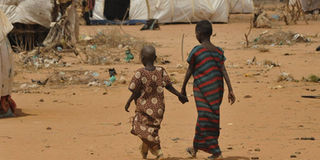Tension amid influx of South Sudan refugees

PHOTO | SIMON MAINA | FILE Refugees at the Daadab camp. More than 3,000 refugees have arrived at Kakuma refugee camp, the second largest in the country after Daadab, in the last two months.
What you need to know:
- More than 3,000 migrants seeking further studies flock to Kakuma in the last two months, causing congestion and disputes
An influx of refugees has hit a refugee camp, sparking tension between the immigrants and locals over natural resources.
On Monday, Turkana West district commissioner Patrick Muriira said that while a number of the refugees were hoping to go for further studies in Kenya and beyond, others were escaping from the hostilities between South Sudan and its northern neighbour. (Read: Cross-border rows sap the Sudans’ energies as internal conflicts persist)
Further studies
He expressed concern over the increased number of immigrants seeking asylum at Kakuma Camp, but added that security had been beefed up.
“More than 3,000 refugees from South Sudan have flocked the camp in the last two months, causing congestion and sparking disputes with area residents,” Mr Muriira said, adding that most were adults seeking further studies.
He said additional security officers had been deployed to the camp to intensify patrols and maintain law and order.
Among the disputed resources include water and wood fuel, with residents accusing refugees of engaging in wanton destruction through uncontrolled harvesting of trees.
Mr Muriira said there were plans to expand the camp once approval was received from the Immigration ministry.
“Congestion at the camp has forced somerefugees to encroach into neighbouring villages,” he said.
He told the Nation in an interview that the underground water level within the refugee camp had also gone low due to the sinking of several boreholes and massive destruction of eco-system as a result of increased demand of firewood.
Kakuma, the second biggest in the country after Daadab, is home to about 100,000 refugees among them 45,000 Somalis, 30,000 South Sudan immigrants and the rest from Ethiopia, Rwanda and Burundi.
“The camp has, in the recent past, been receiving an average of 100 refugees daily, and can become a hide-out for criminals fleeing their country,” Mr Muriira said.
A man was killed and scores injured last month following a clash at the camp, he added.
“Tight security monitoring measures have been put in place at the refugee camp that will be extended to social places to get rid of illegal immigrants and maintain law and order,” the DC said.
Several refugees at the Kakuma camp have established businesses at Kakuma trading centre and Lodwar Town.
Sources say UNHCR spends about Sh18 billion a year on support of refugees.
“It is unfortunate that some of these refugees sell relief supplies donated by humanitarian agencies and flout immigration rules by crossing over to neighbouring countries,” Mr Muriira said.
The camp has more than 10 international humanitarian agencies ranging from the United Nations High Commission for Refugees to the World Food Programme (WFP), among others.
Some of the refugees have been staying with Kenyan Somalis and have established businesses in major towns in parts of the north.
Theft of animals
At the same time, the locals have petitioned the Government and UNHCR to investigate cases of human trafficking at the camp.
A technical committee of Turkana leaders claimed the camp was being used as a transit point for illegal immigrants seeking asylum in other countries.
“The, government must establish anti-human trafficking reporting and monitoring,” urged the leaders in a report on security. They want UNHCR to fence the camp to minimise theft of animals and crime.




